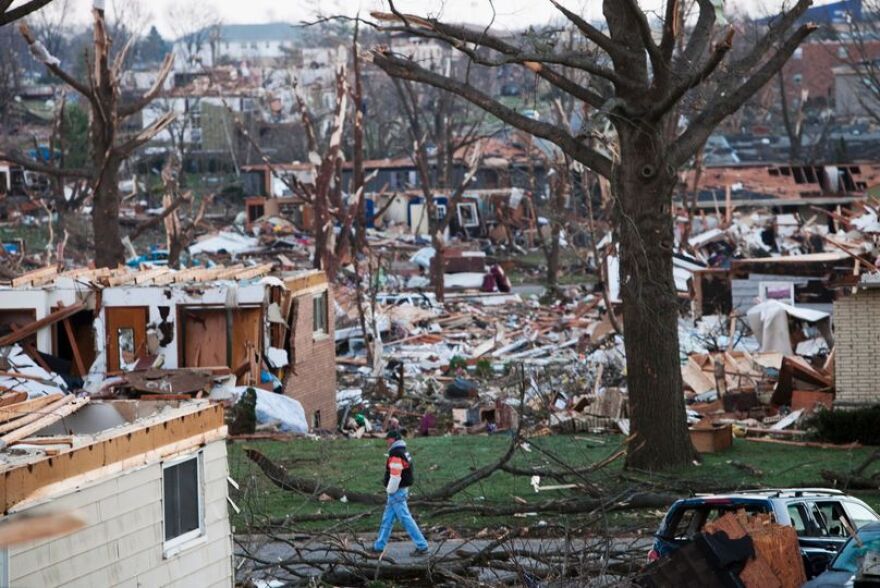Ten years after an EF-4 tornado left a 46 mile long path of destruction through Tazewell and Woodford counties, former state climatologist Jim Angel says changing weather patterns could mean more winter tornadoes in Illinois.
The tornado that struck the heart of Washington was part of an outbreak on November 17, 2013. Temperatures in Central Illinois were in the low 70’s, an unseasonably warm day for mid-November.
The outbreak produced more than 70 tornadoes over multiple states. 25 tornadoes touched down in Illinois.
Angel was the Illinois state climatologist from 1997 to 2018. He said milder winters means there’s the potential for more outbreaks in the fall and winter.
“That's where you get the increased risk of these wintertime events,” he said. “So I would expect, as we move into the future, that's where you'll see more of it. A year round risk of tornadoes in Illinois.”
He said one of the biggest challenges in Washington was the harsh winter which followed the tornado, making clean up difficult.
“The winter (of) 2013-2014 was exceptionally cold and snowy and it was almost literally the next day that that winter started,” Angel said. “So I remember going through Washington, the next spring, I think probably around April, and they were still doing cleanup.”
Illinois and the Midwest is not the only region to be threatened by these changing weather patterns. Some scientists believe climate change is causing tornado hot spots to shift east.
“Tornado Alley” currently is believed to begin in central Texas and stretches north into South Dakota. But less tornadoes have touched down in that region recently, while states including Illinois, Missouri, Arkansas and Alabama have all seen increases in confirmed tornadoes.

Angel said he’s always considered Illinois to be a part of “tornado alley,” as there has always been among the states with the highest number of dangerous tornadoes.
Illinois has had 107 tornadoes this year, the most of any state.
He said it’s hard to know how unusual these numbers are because historical records have not always been properly maintained.
“The old record seemed to suggest that we didn't have nearly as many tornadoes,” Angel said. “But I'm highly skeptical of that, I think what really was happening, and we just were missing out on a lot of the tornadoes. So that makes it hard to talk about trends.”
Angel said there has been an increase in the number of multi-tornado storms in both the Midwest and southeast.
“Many of our tornadoes in Illinois are fortunately fairly weak,” Angel said. “The most common is the EF0’s. And the next most common EF1. So the twos and the threes are fairly rare and the fours are exceptionally rare. And the EF fives, the infamous ones, are extremely rare, which is fortunate, because those are the ones that are most likely to cause death.”
The National Weather Service at Lincoln says only two EF5 tornadoes have been recorded in central and southeast Illinois since 1880.
Angel said the increase in tornado outbreaks could make recovery efforts harder.
“If you have a tornado, then you have mutual aid from surrounding communities come in and help you out,” he said. “But if everybody's getting hammered by tornadoes, then you can't help each other out. So I think that's going to be a challenge for emergency management moving forward. How do you deal with these multi-tornado events?”
Angel said the increase in tornadoes in the Midwest and southeast is also a concern because of population density in those areas.
“In Oklahoma, it's pretty sparsely populated, wide open areas,” he said. “So you can see things coming. To get into the southeast, you get a lot of, there's a lot of forest, a lot of hills. There's a lot of mobile homes that are much more vulnerable to tornadoes than a regular house or business. So that's been a real problem in recent years.”
Tornadoes can develop anywhere, including major cities such as Chicago. Angel said they have been recorded to cross rivers such as the Illinois river and aren’t impacted much by hills.
“They kind of follow the terrain. So they go up and down,” he said. “In fact, we've had some pretty significant tornadoes that have jumped the river. There's one back in the early 1900s in St. Louis that went from St. Louis to East St. Louis, without slowing down, and that goes across the Mississippi River.”
In fact, there’s only one physical feature in Illinois which Angel said would stop a tornado.
“Lake Michigan, but that's if you're out on Lake Michigan,” he said. “That's about the only thing that does seem to have an impact on severe thunderstorms and tornadoes, though, we don't live on the lake so much.”
He said it’s still very rare for any town or city to be hit by a tornado, but it does happen. He said advancements in warning systems means people often know when a tornado is coming.
While many might see the tornado warning and head outside, Angel cautions against it.
“I’ve been guilty of that, too, as my wife will tell you,” he said. “It is that kind of human instinct that you want to see it first and believe it, but that can be a problem, because you may not see until the very last minute and you may only have seconds to seek shelter.”
A tornado warning means that one has been spotted on the ground, so people should seek shelter immediately. Angel said people should also be weary of lighting, as it’s harder to track and can cause severe burns, brain damage and death.


